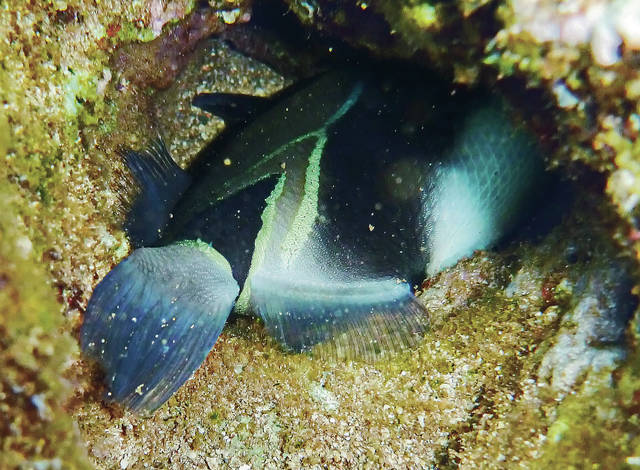Published in the Ocean Watch column, Honolulu Star-Advertiser © Susan Scott
July 21, 2018
Last week reader Peter Ko emailed, “I recently had a rather unpleasant encounter with our state fish while swimming near the reef on the Big Island. Without any warning, I felt a tug and a pain on my left foot. I turned around and saw the fish coming at me again! I was baffled and tried to scare it off. But it kept coming at me, for no less than a dozen times, while I tried to get out of its reach. I was subsequently told by the lifeguard that the fish was nesting, and I was viewed as an intruder.”
Peter is referring to the fish that in 1985 the state Legislature named Hawaii’s state fish, a 10-inch-long species with oodles of names.
 A North Shore triggerfish locked and loaded.
A North Shore triggerfish locked and loaded.
©2018 Susan Scott
Hawaiians named it the humuhumunukunukuapuaa, meaning “fish that grunts like a pig,” which it does when cornered or pursued. In English the fish is called the wedge or wedge-tailed triggerfish, reef triggerfish and rectangular triggerfish. Those in science circles know the common, colorful fish as Rhinecanthus rectangulus.
The lifeguard was right. Peter had likely strayed too close to a triggerfish’s eggs and upset the mother.
In damselfish, such as Hawaiian sergeants, it’s the feisty males who try to chase away or even nip anyone who gets too close to the eggs. Those eggs appear as purplish masses stuck to rocks near the reef floor.
But a snorkeler or diver won’t usually see a triggerfish’s clear eggs laid in a sand depression prepared by the male. After fertilizing one female’s eggs, the male swims off to defend a larger territory that contains the rest of his harem. Each female, however, sticks with her own future offspring, becoming their fierce guardian.
Triggerfish have sharp teeth, sometimes delivering more than a nip. The internet is full of stories and photos of several species of triggerfish biting people feeding, photographing or just accidentally swimming too close to a protective female, as Peter did. But bites are rare. Most of us who are in the water often have never been bitten.
Hawaii hosts 11 triggerfish species, all of which lay their eggs on the ocean floor and all of which are guarded by protective mothers. This exhausting work doesn’t last long. The eggs are laid and fertilized at dawn and hatch the following night.
Peter wonders whether there’s a particular time of year to watch out for triggerfish safeguarding their eggs. Sort of. Peak spawning months vary according to species, but in general it’s common to see breeding behaviors and baby triggerfish in spring and summer on Hawaii’s reefs. Tropical fish, however, can spawn year-round.
Triggerfish get their name from two spines on their back that can lock in an upright position. When a triggerfish is startled, it dives into a rock hole headfirst, raises its triggers and stays wedged in there until the danger has passed.
That’s why all my wedge triggerfish pictures show their tails. But that’s OK. I would rather have a close encounter with a hiding triggerfish’s rear end than with a angry triggerfish’s front teeth.